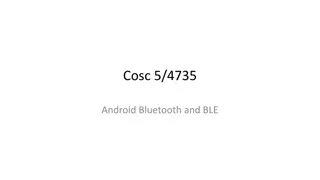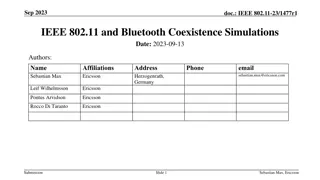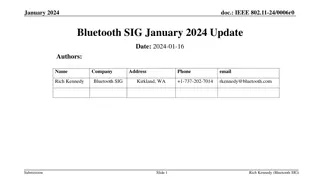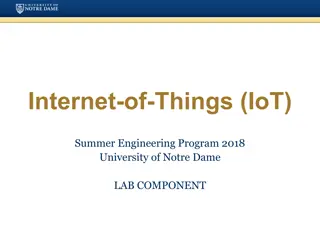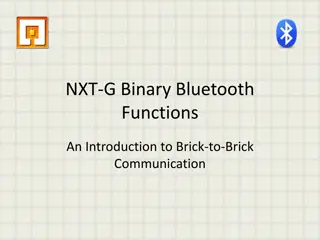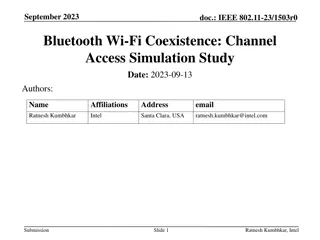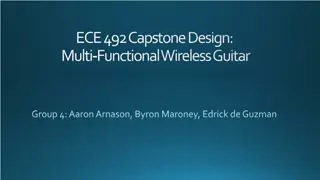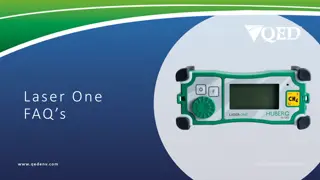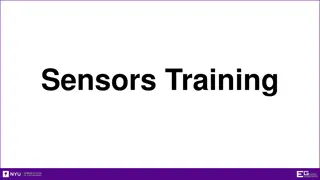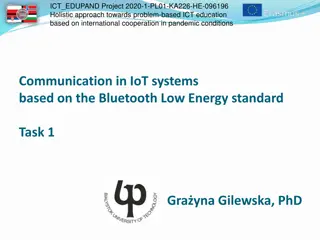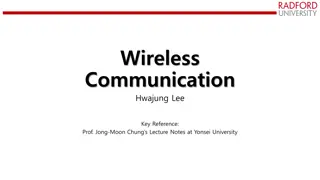The World of Bluetooth Technology
Discover the fascinating world of Bluetooth technology which enables wireless connections between various electronic devices without the need for cables. Learn about its development by a group of renowned electronics manufacturers, its association with King Harald Bluetooth of Denmark, and how it overcomes the limitations of traditional wireless technologies. Bluetooth provides a seamless way for devices to communicate securely through radio-frequency standards, allowing for efficient data transmission and creating ad-hoc networks. Dive into the concept of piconets and the practical applications of Bluetooth technology in modern-day electronics.
Download Presentation

Please find below an Image/Link to download the presentation.
The content on the website is provided AS IS for your information and personal use only. It may not be sold, licensed, or shared on other websites without obtaining consent from the author.If you encounter any issues during the download, it is possible that the publisher has removed the file from their server.
You are allowed to download the files provided on this website for personal or commercial use, subject to the condition that they are used lawfully. All files are the property of their respective owners.
The content on the website is provided AS IS for your information and personal use only. It may not be sold, licensed, or shared on other websites without obtaining consent from the author.
E N D
Presentation Transcript
Bluetooth is developed by a group of electronics manufacturers that will allow any sort of electronic equipment -- from computers and cell phones to keyboards and headphones -- to make its own connections, without wires, cables or any direct action from a user.
The Bluetooth Special Interest Group comprises more than 1000 companies.The major companies who created the technology include Intel 3 com Ericcson IBM Motorola Nokia Toshiba
The Name Bluetooth? The name is attributed to Harald Bluetooth was king of Denmark . Choosing this name for the standard indicates how important companies from the Baltic region (nations including Denmark, Sweden, Norway and Finland) are to the communications industry
Present wireless technology like infra red data communication has two problems 1)Line of Sight 2) One to One Using data synchronizing e.g. syn on a PDA --- problem of using the right cradle and cable. BLUETOOTH OVERCOMES THESE PROBLEMS
It provides agreement at the physical level -- Bluetooth is a radio-frequency standard. Provides agreement at the data link level where products have to agree on when bits are sent how many will be sent at a time how the parties in a conversation can be sure that the message received is the same as the message sent
The Basic Idea Bluetooth is a standard for a small , cheap radio chip to be plugged into computers, printers, mobile phones, etc Bluetooth chip is designed to replace cables.Information normally carried by the cable, is transmitted at a special frequency to a receiver Bluetooth chip. These devices can form a quick ad-hoc secure piconet and start communication. Connections in the piconets can occur even when mobile.
Piconet A collection of devices connected via Bluetooth technology in an ad hoc fashion. A piconet starts with two connected devices, and may grow to eight connected devices. All Bluetooth devices are peer units and have identical implementations. However, when establishing a piconet, one unit will act as a Master and the other(s) as slave(s) for the duration of the piconet connection.
Requirements Low cost as cables chip $5 Secure as cables must support authentication and encryption Must support both data and voice. Must connect to a variety of devices. Must be able to function in a noisy environment. Data rates 721kbps , using the 2.45Ghz radio frequency band I.S.M (Industrial, scientific and medical) Must support many simultaneous and private piconets . Must be low power, compact and global.
Usage Models- Voice/Data Access Points Connecting a computing device to a communicating device. Allows any device with a bluetooth chip to connect to the internet while located within the range of the access point. Example- a notebook could link to the internet using a mobile phone as an access point.
Usage models-Peripheral Interconnects Standard peripheral devices like keyboard, mice, headsets etc working over a wireless link. The same device can be used in multiple functions e.g a headset can access phones while in the office and can interface with a cellular phone when mobile.
Usage model- Personal Area Networking.(PAN) Allows dynamic formation and breakdown of PICONETS --ad-hoc personal networks.
Bluetooth Architecture Core Specification -Deals with the lower layers of the architecture and describes how the technology works. Profile Specification - Focuses on how to build interoperating devices using the core technology.
RF Layer The Radio (layer) is the lowest defined layer of the Bluetooth specification. It defines the requirements of the Bluetooth transceiver device operating in the 2.4GHz ISM band.
In order to minimize interference the nominal antenna power is 1 mW which can be extended to 100mW. The low power limits the range to about 10 centimeters to 10 meters. With higher power of 100mW range of 100meters can be achieved. It uses a packet switching protocol based on a technology called spread-spectrum frequency hopping to spread the energy across the ISM band.
Spread Spread- -Spectrum frequency hopping Spectrum frequency hopping A device will use 79 individual randomly chosen frequencies within a designated range, changing from one to another on a regular basis. The designated range is from 2.402GHz to 2.480GHz, in steps of 1MHz. The frequency hopping is done at a rate of 1600 times a second. This allows more devices to use the limited time slice and secondly reduces the chance of two transmitters being on the same frequency at the same time.
Baseband layer This layer defines the timing, framing, packets and flow control on the link. Link Manager Responsible for managing connection states(authentication & encryption), enforcing fairness among slaves & power mangt. Logical Link Layer Handles multiplexing, segmentation and reassembly of large packets and device discovery. Audio The audio data is directly mapped to the baseband layer.
Bluetooth Frame Each frame consists of a transmit packet and a receive packet. Each packet may have either 1, 3 or 5 slots of 625 s. Single slot packet max data rate of 172Kbps Multislot frames support higher rates 721Kbps or a max. of 3 voice channels.
Network Topology All units have a unique global ID(BD_Addr) address( 48 bits) The unit that initializes the connection is assigned as the master which controls the traffic of the connection. A master can simultaneously connect upto seven slaves. The master/slave roles can be swapped. A device can be a master in only one piconet at a time.
Forming a piconet Needs two parameters --- a) Hopping pattern of the radio it wishes to connect. b) Phase within the pattern i.e. the clock offset of the hops. The global ID defines the hopping pattern. The master shares its global ID and its clock offset with the other radios which become slaves. The global ID and the clock parameters are exchanged using a FHS (Frequency Hoping Synchronization) packet.
Devices not connected to a piconet are in STANDBY mode, using low power. A connection is made by either a PAGE command if the address is known or by the INQUIRY command followed by a PAGE When a radio sends an INQUIRE command, all the listening radios respond with their FHS packets, which tells the inquiring radio of all the radios in the area. All listening radios perform a page scan and/or an inquiry scan every 1.25 seconds. The master radio sends an FHS to the paged radio.
Shows a bunch of bluetooth devices in proximity of each other. Each device has its own ID and its clock offset
Radio A has become the master and has formed a piconet with B and C as the slaves. Both B and C now share A s ID and and clock offset.
When a radio joins a piconet it is assigned a 3 bit Active Member Address(AMA). Once the piconet has eight radios, the master assigns puts a radio into the PARK mode. This is one of the low power states, in which the radio releases its AMA for a 8 bit PMA (Passive Member Address). The freed AMA can be assigned to another radio wishing to join the piconet. Though upto 256 radios can actively reside on a piconet, only 8 of them with AMA s can transfer data.
Once a radio joins the piconet and has an AMA it can direct data to other devices on the piconet. In order to remain in the connected state within a piconet, the radio needs to maintain the frequency hopping pattern and offset while consuming low power. To achieve this the connected radios can be placed in either PARK, HOLD or SNIFF modes.
HOLD MODE When data needs to be transmitted very infrequently, thus conserving power. In this mode only an internal timer is running. No data is transferred when in HOLD mode. The master can put slaves on HOLD mode. SNIFF MODE A slave device listens to the piconet at a reduced rate. The SNIFF interval is programmable. In both the HOLD and SNIFF states the device retains its AMA.
PARK MODE The device has given up the AMA and has become passive. The parked device will occasionally listen to see if the master has sent any broadcast data asking it to become active.
Types of Links and Packets Synchronous Connection Oriented(SCO) Point to point full duplex link. Typically used for voice data. These packets do not use CRC and are not retransmitted. Needs an asynchronous connectionless (ACL) type link to be first established.
Asynchronous Connectionless Link This is a packet switched link between a master and slave. Supports both isochronous and asynchronous data. Error Correction Schemes Forward error correction(1/3 and 2/3) Automatic Repeat Request scheme.
Security Authentication and encryption is provided at the Link Manager layer. The PIN is translated into a 128 bit link key which is used for authentication. After authentication the radios will settle on a suitable length encryption key to be used. Bluetooth relies on PIN codes to establish trusted relationships between devices.




